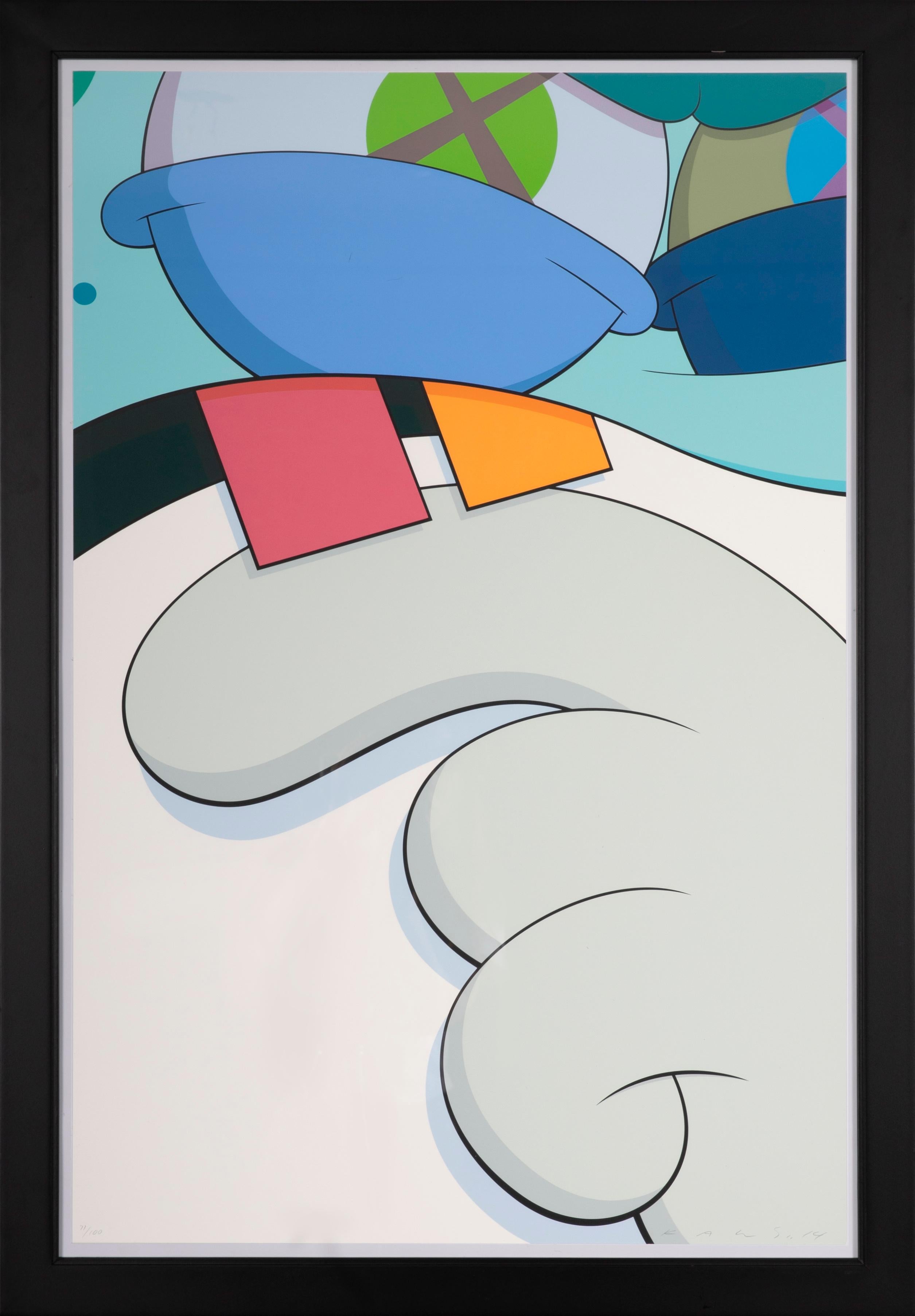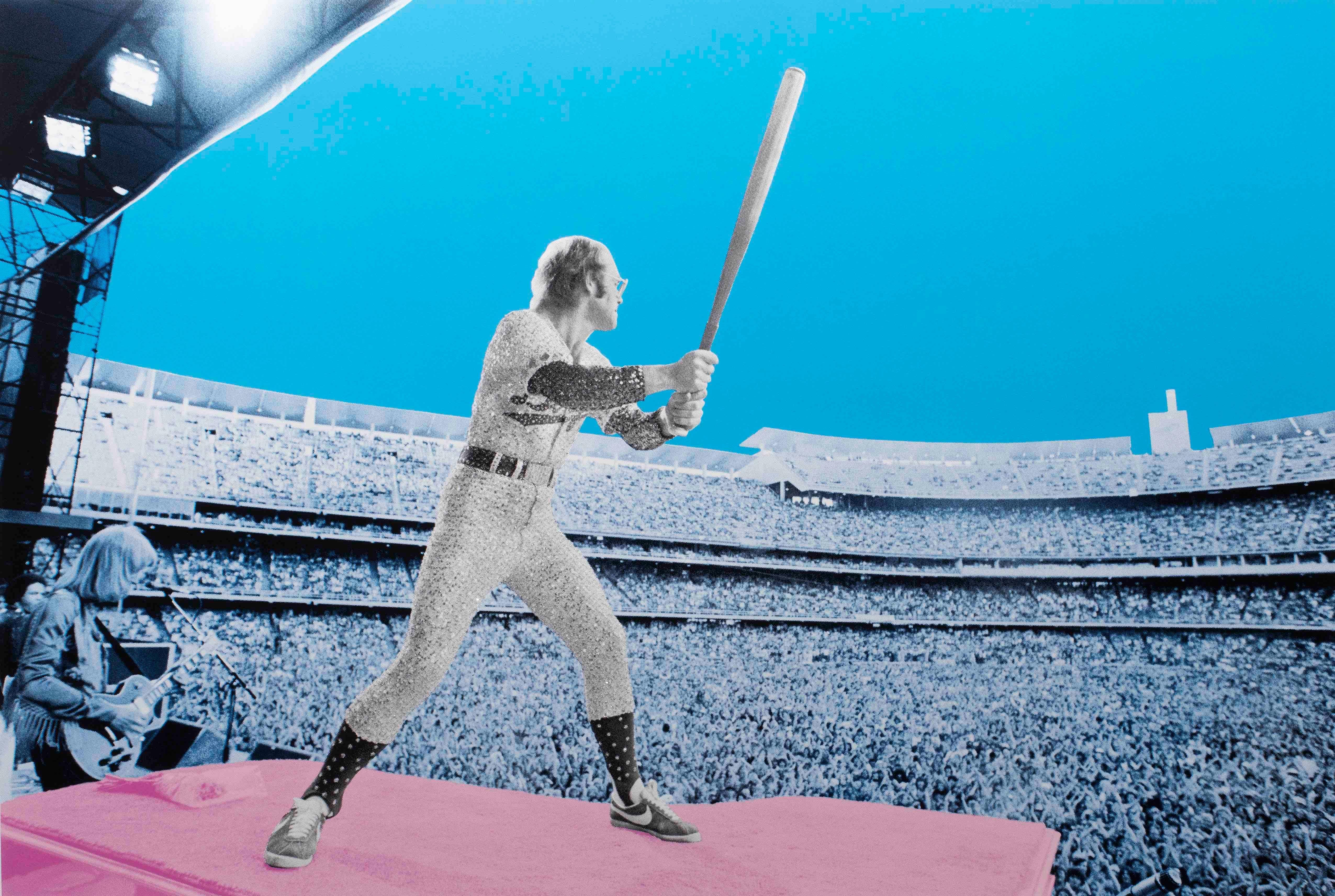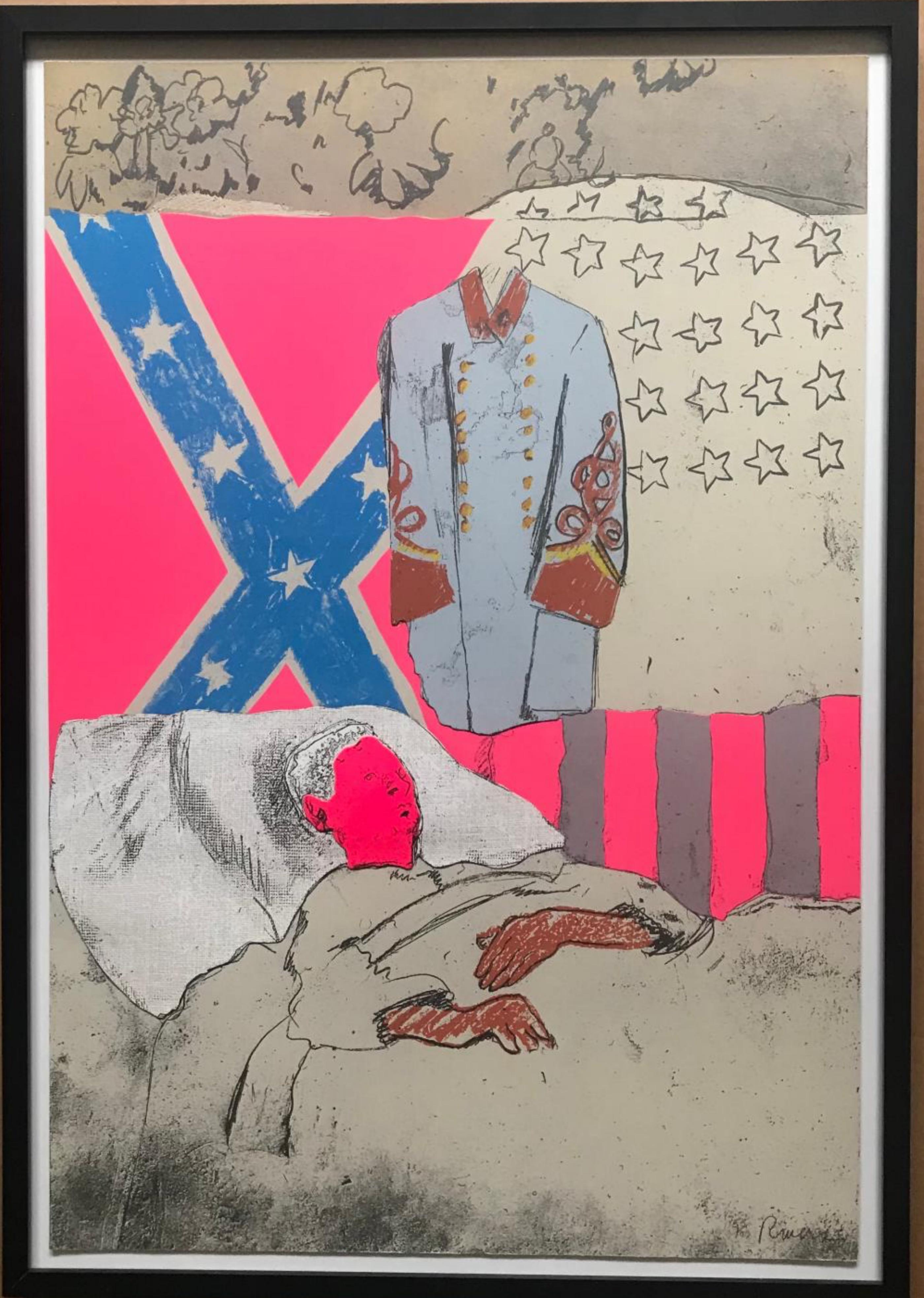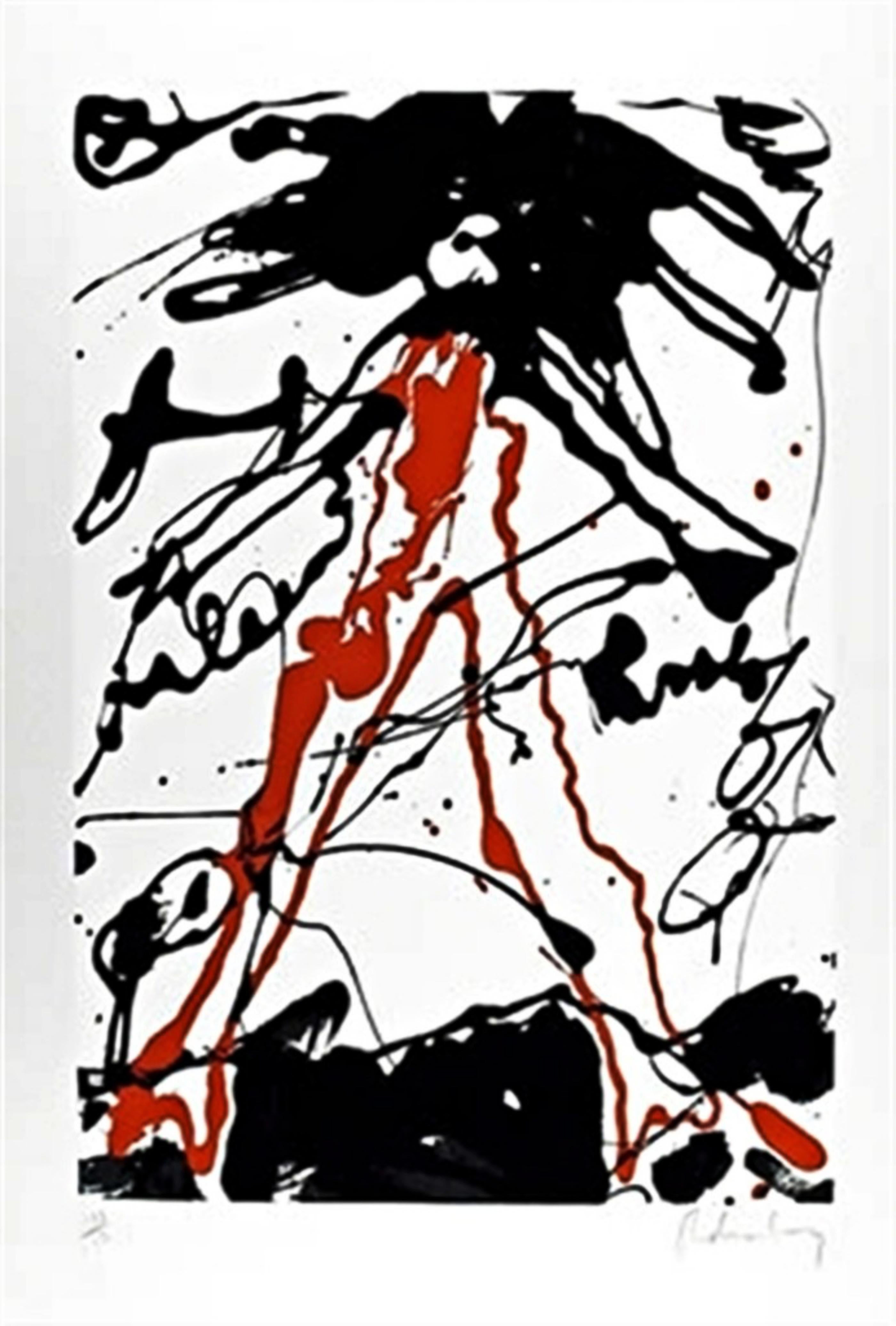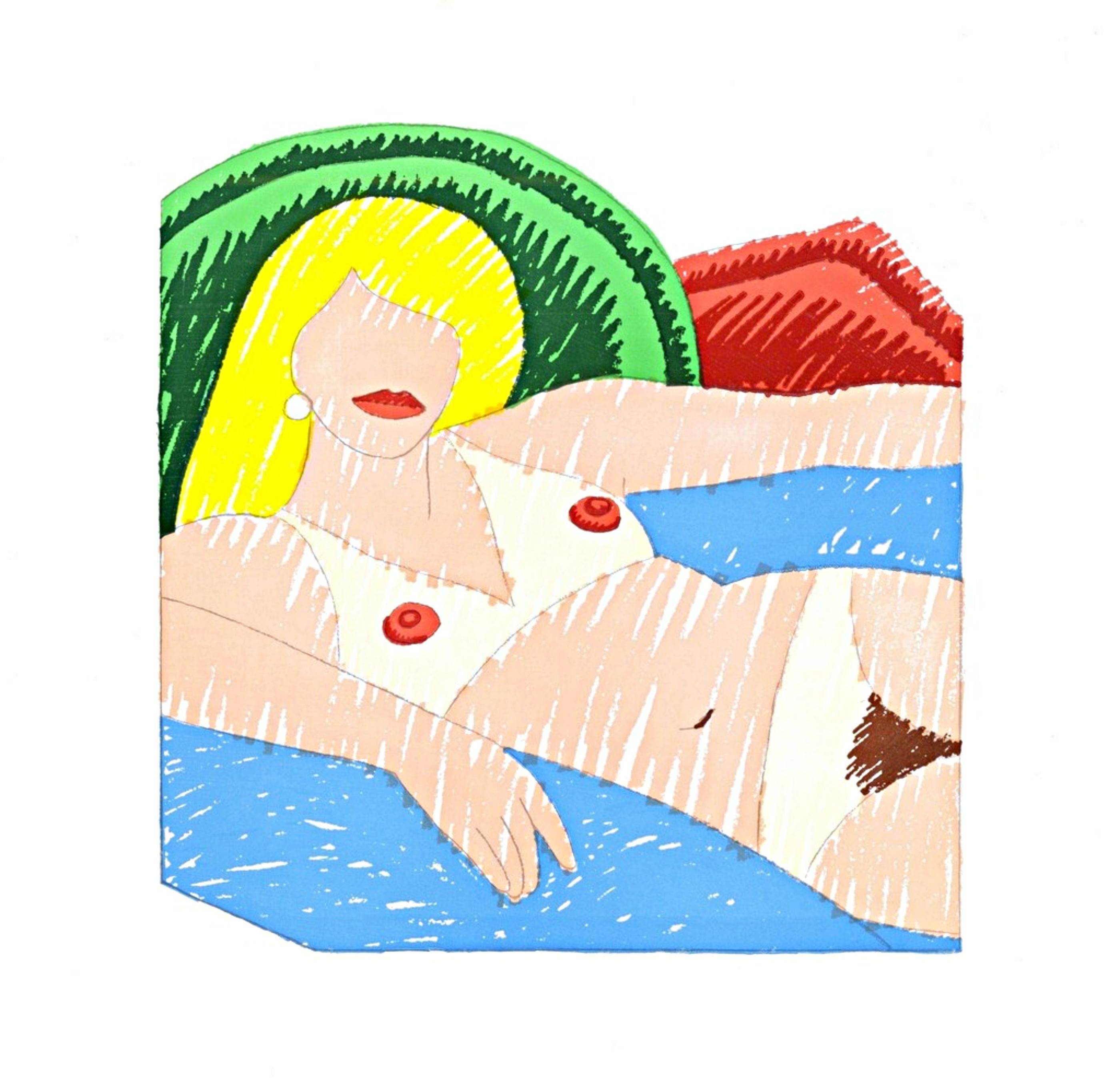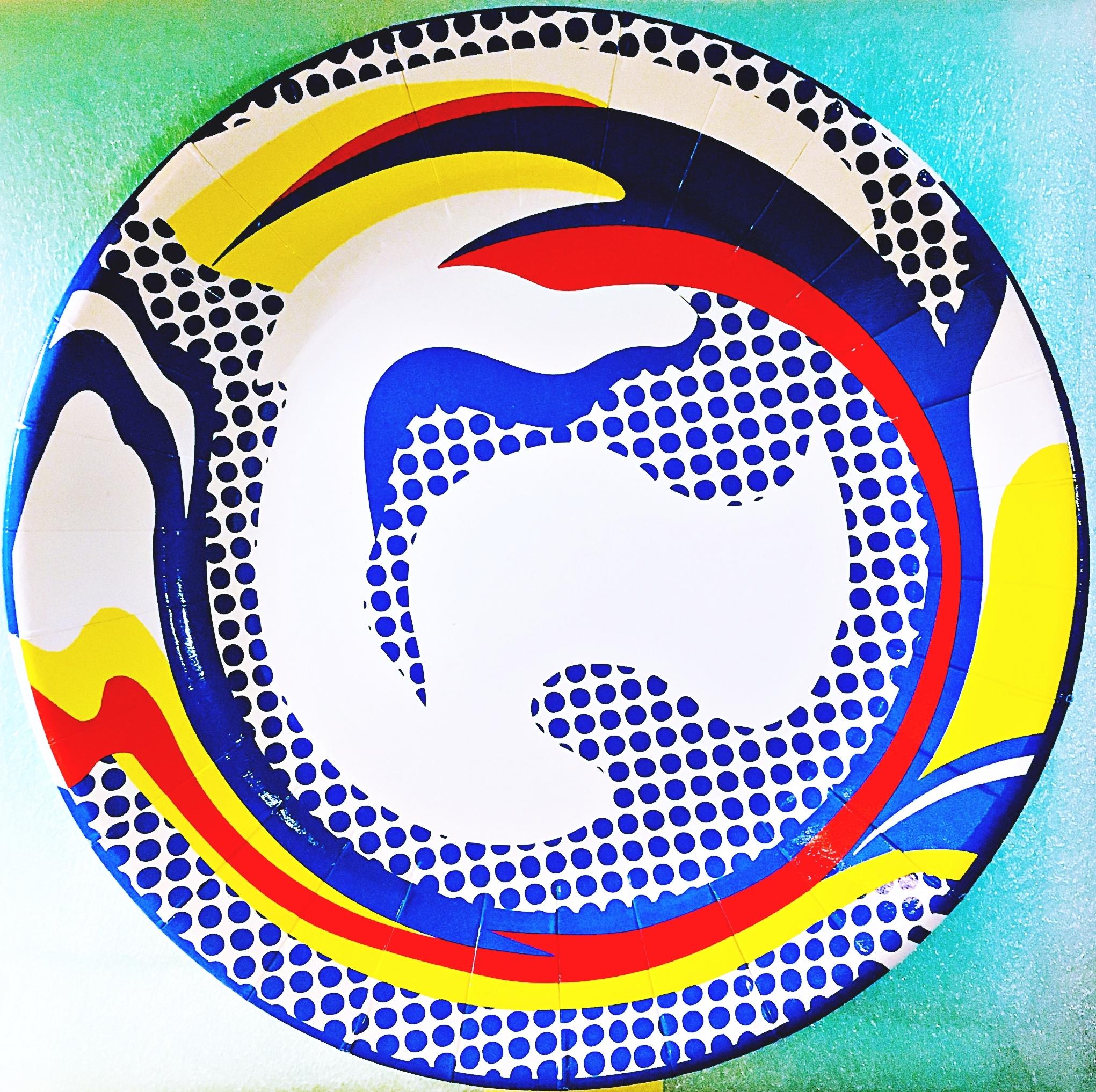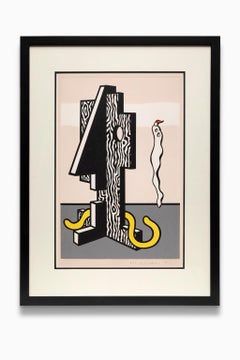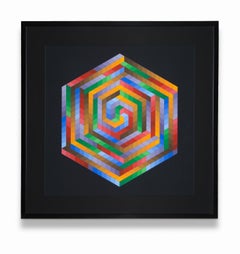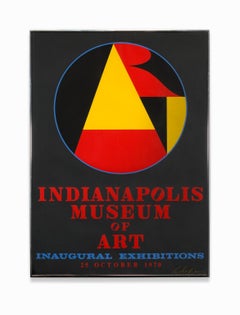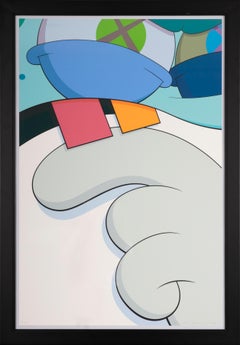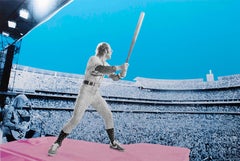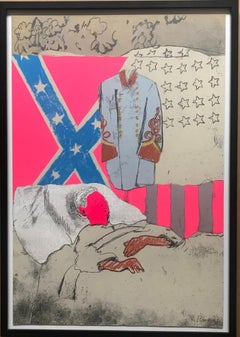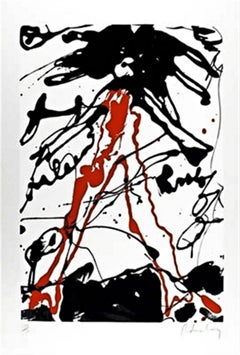Items Similar to "Cameroon" Silk Screen Serigraph, Geometric Abstract, Pop-Art, Colors on Buff
Want more images or videos?
Request additional images or videos from the seller
1 of 13
Thomas Lahy"Cameroon" Silk Screen Serigraph, Geometric Abstract, Pop-Art, Colors on Buff1980s
1980s
About the Item
“Cameroon” is a striking, large, artwork by a mid-century modernist artist and print maker Thomas Lahy. This is a framed silkscreen serigraph. The geometry-inspired abstract design is reminiscent of early modernist work by the suprematism and de stijl/Bauhaus art movements. The color scheme combines tones of red, orange, green, blue, pink, and yellow accents on beige and brown. Lahy was born in Detroit and after studying painting at Michigan State University it is said that he became Michigan’s foremost practitioner of Op Art and Color Field painting.
The artwork is numbered lower left, titled in center, and signed lower right. Unframed the visible art measures approximately 35.50" h x 23.50" w. This piece is numbered 30 from an edition of 60.
About the Seller
5.0
Vetted Professional Seller
Every seller passes strict standards for authenticity and reliability
Established in 2014
1stDibs seller since 2019
107 sales on 1stDibs
Typical response time: 1 to 2 days
- ShippingRetrieving quote...Shipping from: Detroit, MI
- Return Policy
Authenticity Guarantee
In the unlikely event there’s an issue with an item’s authenticity, contact us within 1 year for a full refund. DetailsMoney-Back Guarantee
If your item is not as described, is damaged in transit, or does not arrive, contact us within 7 days for a full refund. Details24-Hour Cancellation
You have a 24-hour grace period in which to reconsider your purchase, with no questions asked.Vetted Professional Sellers
Our world-class sellers must adhere to strict standards for service and quality, maintaining the integrity of our listings.Price-Match Guarantee
If you find that a seller listed the same item for a lower price elsewhere, we’ll match it.Trusted Global Delivery
Our best-in-class carrier network provides specialized shipping options worldwide, including custom delivery.More From This Seller
View AllRoy Lichtenstein "Figures" 1978 (From Surrealist Series) Gemini G.E.L. Printers
By Roy Lichtenstein
Located in Detroit, MI
SALE ONE WEEK ONLY
Title: Figures
Portfolio: 1978 Surrealist
Medium: Lithograph on Arches 88 paper
Edition: 38
Sheet Size: 31 7/16" x 23 1/2" Image Size: 23 1/2" x 15 1/4"
Signature: Hand signed in pencil
Reference: Corlett 156
Printed by Gemini G.E.L. printers out of Los Angeles.
Roy Fox Lichtenstein was an American pop artist. During the 1960s through the 90’s, along with Andy Warhol, Jasper Johns, and James Rosenquist, he became a leading figure in the new art movement. His work defined the premise of pop art through parody. Most of Lichtenstein's best-known works are relatively close, but not exact, copies of comic book panels, a subject he largely abandoned in 1965. Lichtenstein's Still Life paintings, sculptures and drawings, which span from 1972 through the early 1980s, cover a variety of motifs and themes, including the most traditional such as fruit, flowers, and vases.
Inspired by the comic strip, Lichtenstein produced precise compositions that documented while they parodied, often in a tongue-in cheek manner. His work was influenced by popular advertising and the comic book style. His artwork was considered to be "disruptive". He described pop art as "not 'American' painting but actually industrial painting". His paintings were exhibited at the Leo Castelli Gallery in New York City.
Wham!, and Drowning Girl Look Mickey proved to be his most influential works. His most expensive piece is Masterpiece which was sold for $165 million in January 2017.
Lichtenstein received both his Bachelors and Masters at Ohio State University, Columbus, Ohio where he taught for ten years. In 1967, he moved back to upstate New York and began teaching again.
It was at this time that he adopted the Abstract Expressionist style, being a late convert to this style of painting. Lichtenstein began teaching in upstate New York at the State University of New York at Oswego in 1958. About this time, he began to incorporate hidden images of cartoon characters such as Mickey Mouse and Bugs Bunny into is abstract works.
In 1960, he started teaching at Rutgers University where he was heavily influenced by Allan Kaprow, who was also a teacher at the university. This environment helped reignite his interest in Proto-pop imagery. In 1961, Lichtenstein began his first pop paintings using cartoon images and techniques derived from the appearance of commercial printing. This phase would continue to 1965, and included the use of advertising imagery suggesting consumerism and homemaking. His first work to feature the large-scale use of hard-edged figures and Ben-Day dots was Look Mickey (1961), National Gallery of Art, Washington, D. C.) This piece came from a challenge from one of his sons, who pointed to a Mickey Mouse comic book and said; "I bet you can't paint as good as that, eh, Dad?" In the same year he produced six other works with recognizable characters from gum wrappers and cartoons.
It was at this time that Lichtenstein began to find fame not just in America but worldwide. He moved back to New York to be at the center of the art scene in 1964 to concentrate on his painting. Lichtenstein used oil and Magna (early acrylic) paint in his best known works, such as Drowning Girl (1963), which was appropriated from the lead story in DC Comics’ Secret Hearts No. 83, drawn by Tony Abruzzo. (Drowning Girl now hangs in the Museum of Modern Art, New York.) Drowning Girl also features thick outlines, bold colors and Ben-Day dots, as if created by photographic reproduction. Of his own work Lichtenstein would say that the Abstract Expressionists "put things down on the canvas and responded to what they had done, to the color positions and sizes. My style looks completely different, but the nature of putting down lines pretty much is the same; mine just don't come out looking calligraphic, like Pollock’s or Kline’s.
Rather than attempt to reproduce his subjects, Lichtenstein's work tackled the way in which the mass media portrays them. He would never take himself too seriously, however, saying: "I think my work is different from comic strips – but I wouldn't call it transformation; I don't think that whatever is meant by it is important to art.” When Lichtenstein's work was first exhibited, many art critics of the time challenged its originality. His work was harshly criticized as vulgar and empty. The title of a Life magazine article in 1964 asked, "Is He the Worst Artist in the U.S.?" Lichtenstein responded to such claims by offering responses such as the following: "The closer my work is to the original, the more threatening and critical the content. However, my work is entirely transformed in that my purpose and perception are entirely different. I think my paintings are critically transformed, but it would be difficult to prove it by any rational line of argument.”
In 1969, Lichtenstein was commissioned by Gunter Sachs to create Composition and Leda and the Swan, for the collector's Pop Art bedroom suite at the Palace Hotel in St. Moritz. In the late 1970s and during the 1980s, Lichtenstein received major commissions for works in public places: the sculptures Lamp (1978) in St. Mary's, Georgia; Mermaid (1979) in Miami Beach; the 26 feet tall Brushstrokes in Flight (1984, moved in 1998) at John Glenn Columbus International Airport; the five-storey high Mural with Blue Brushstroke (1984–85) at the Equitable Center, New York and El Cap de Barcelona (1992) in Barcelona. In 1994, Lichtenstein created the 53-foot-long, enamel-on-metal Times Square Mural in Times Square subway station. In 1977, he was commissioned by BMW to paint a Group 5 Racing Version of the BMW 320i for the third installment in the BMW Art Car Project. The DreamWorks Records logo was his last completed project. "I'm not in the business of doing anything like that (a corporate logo) and don't intend to do it again," allows Lichtenstein. "But I know Mo Ostin and David Geffen and it seemed interesting.
In 1996 the The National Gallery of Art in Washington, D.C. became the largest single repository of the artist's work when Lichtenstein donated 154 prints and 2 books. The Art Institute of Chicago has several important works by Lichtenstein in its permanent collection, including Brushstroke with Spatter (1966) and Mirror No. 3 (Six Panels) (1971). The personal holdings of Lichtenstein's widow, Dorothy Lichtenstein, and of the Roy Lichtenstein Foundation number in the hundreds. In Europe, the Museum Ludwig in Cologne has one of the most comprehensive Lichtenstein holdings with Takka Takka (1962), Nurse (1964), Compositions I (1964), besides the Frankfurt Museum fur Modern Kunst with We Rose Up slowly (1964), and Yellow and Green Brushstrokes...
Category
1970s Pop Art Abstract Prints
Materials
Lithograph
Victor Vasarely Screen Print Abstract, Geometric Squares Cubes Hexagon
By Victor Vasarely
Located in Detroit, MI
Victor Vasarely born in 1906 was a Hungarian-French artist, who is widely accepted as a "grandfather" and leader of the Op Art movement. Op Art is a form of abstract art that gives the illusion of movement by the precise use of pattern and color, or in which conflicting patterns emerge and overlap. Victor Vasarely and Brigit Riley are its most famous exponents. In its visual balancing act of color and movement from a flat plane to developed continuous flow “Untitled” is a complex arrangement of squares and colors that visually expand and contract. It is one of Vasarely’s most successful Op Art abstract works. The piece is signed on the lower right and number 20/150 on the lower left. The print is behind glass and matted.
Vasarely was born in Pecs and grew up in Slovakia and Budapest, where in 1925, he took up medical studies. Abandoning medicine he turned to traditional academic painting at the private Podolini-Volkmann Academy. In 1928/1929, he enrolled at Sandor Bortnyik’s private art school widely recognized as Budapest's centre of Bauhaus studies. His studies concentrated on applied graphic art and typographical design. In 1929, he painted his Blue Study and Green Study. In 1930, he married his fellow student Claire Spinner (1908–1990). Together they had two sons, Andre and Jean-Pierre. Vasarely became a graphic designer and a poster artist during the 1930s combining patterns and organic images with each other.
Vasarely utilized geometric shapes and colorful graphics, the artist created compelling illusions of spatial depth, as seen in his work Vega-Nor (1969). Vasarely’s method of painting borrowed from a range of influences, including Bauhaus design principles, Wassily Kandinsky, and Constructivism. In the late 1920s, Vasarely enrolled at the Muhely Academy in Budapest, where the syllabus was largely based on Walter Gropius’s Bauhaus school in Germany.
After settling in Paris in 1930, Vasarely worked in advertising agencies to support himself as a graphic artist while creating many works including Zebra (1937), which is considered by some to be one of the earliest examples of Op Art. The artist experimented in a style based in Surrealism and Abstract Expressionism during the 1940s, before arriving at his hallmark checkerboard...
Category
Mid-20th Century Op Art Abstract Prints
Materials
Paper, Screen
"Indianapolis Museum of Art Inaugural Exhibitions", Color Silkscreen, Signed
By Robert Indiana
Located in Detroit, MI
"Indianapolis Museum of Art Inaugural Exhibitions", 25 October 1970, is an eye popping large bold colorful geometric abstract silk screen. It is signed on the lower right.
Robert Indiana, one of the preeminent figures in American art since the 1960s, played a central role in the development of assemblage art, hard-edge painting, Pop art, Neo-Dada, American Modernism and Modern Art. A self-proclaimed “American painter of signs,” Indiana created a highly original body of work that explores American identity, personal history, and the power of abstraction and language, establishing an important legacy that resonates in the work of many contemporary artists such as Andy Warhol, Keith Haring, Roy Lectenstein, David Hockney, Romero Britto, Richard Hamilton and Robert Rauschenberg who make the written word a central element of their oeuvre.
Robert Indiana was born Robert Clark in New Castle, Indiana on September 13, 1928. Adopted as an infant, he spent his childhood moving frequently throughout his namesake state. At 14 he moved to Indianapolis in order to attend Arsenal Technical High School, known for its strong arts curriculum. After graduating he spent three years in the U.S. Air Force and then studied at the Art Institute of Chicago, the Skowhegan School of Sculpture and Painting in Maine, and the Edinburgh College of Art in Scotland.
In 1956, two years after moving to New York, Indiana met Ellsworth Kelly, and upon his recommendation took up residence in Coenties Slip, where a community of artists that would come to include Kelly, Agnes Martin, James Rosenquist, and Jack Youngerman had studios. Indiana, like some of his fellow artists, scavenged the area’s abandoned warehouses for materials, creating sculptural assemblages from old wooden beams, rusted metal wheels, and other remnants of the shipping trade that had thrived in Coenties Slip. The discovery of 19th century brass stencils led to the incorporation of brightly colored numbers and short emotionally charged words onto these sculptures as well as canvases, and became the basis of his new painterly vocabulary.
Although acknowledged as a leader of Pop, Indiana distinguished himself from his Pop peers by addressing important social and political issues and incorporating profound historical and literary references into his works. In 1964 Indiana accepted Philip Johnson’s invitation to design a new work for the New York State Pavilion at the New York World’s Fair, creating a 20-foot EAT sign...
Category
1970s American Modern Abstract Prints
Materials
Paper, Ink, Screen
Giuseppe Capogrossi Iconic Comb Design "Superficie 324" Serigrafia
By Giuseppe Capogrossi
Located in Detroit, MI
"Superficie 324" is a 1988 screen print (serigraph) of a 1959 painting by Capogrossi. This is one of his famous "comb" or "fork" works that he perfected in the 1950s and continued to create for the remainder of his life. The blocks of primary red and yellow colors give a bright, joyful feel and contrast to the strong bold black that was Capogrossi's consistent color for the "combs". With no allegorical, psychological, or symbolic meanings, these structural elements could be assembled and connected in countless variations. Intricate and insistent, Capogrossi's signs determined the construction of the pictorial surface. This piece is identified along one side: Giuseppe Capogrossi By SIAE 1988 Silvio Zamorani Editor Via Saccarelli, 9 10144 Torino Italy Tel. (39)(11) 4730554 Progetto Grafico (Graphic Project): Studio Walter Benjamin. Serigrafia (Screen Print): BISI Torino.
Capogrossi was born in Rome. After obtaining a degree in law in 1923–1924, he decided to study painting with Felice Carena at Accademia di Belle Arti di Roma. In 1927 Capogrossi embarked on a formative trip to Paris together with fellow artists and acquaintances Fausto Pirandello, Corrado Cagli and Emanuele Cavalli...
Category
1950s Abstract Expressionist Abstract Prints
Materials
Screen
Joyce T. Nagel Collagraph "Earthcore" Signed Dated Ltd Ed
Located in Detroit, MI
"Earthcore" is an abstract of a familiar image ... a view of earth sliced in half usually as an explanation of the many layers of spaceship earth. This print is more than its title. It is rich in its depth of color and texture. Upon close inspection there is much activity on the surface which continually adds to its visual complexity.
The name given to this print process is “Collagraph” It is made by glueing different materials to cardboard and creating a kind of collage. During the inking process the ink will rub off surfaces that are smooth or higher and stay on surfaces that hold more ink, at edge and at lower points thus creating the image. To protect the plate through the printing process it’s sealed with one or more layers of shellac. A collagraph plate is quite sensitive and will be deformed by the pressure of the printing press.
Joyce Tilley Nagel...
Category
1960s Abstract Expressionist Abstract Prints
Materials
Paper, Ink
Joyce T. Nagel Collagraph "Grid Melt" Deep Rich Colors Signed Dated
Located in Detroit, MI
"Grid Melt" is one of the monoprints that Joyce Nagel so enjoyed creating. Being a monoprint makes this piece totally unique and unlike any of the other pi...
Category
1980s Abstract Prints and Multiples
Materials
Paper, Ink
You May Also Like
'Blame Game' III, Silkscreen print on paper
By KAWS
Located in New York, NY
The ‘Blame Game' series by KAWS is an exceptionally rare collection of prints, with a total of ten in the portfolio series created in 2014. The KAWS motif has become instantly recogn...
Category
2010s Pop Art Abstract Prints
Materials
Paper, Screen
Elton John: Home Run-Dodger Stadium 1975, Celebrity Prints, Elton John Art
By David Studwell
Located in Deddington, GB
This limited edition is an exciting new collaborative project between Sir Elton John, world-renowned photographer Terry O’Neill, and innovative artist David Studwell. In the lead-up ...
Category
2010s Pop Art Landscape Paintings
Materials
Paper, Screen
The Last Civil War Veteran limited edition signed mixed media silkscreen collage
By Larry Rivers
Located in New York, NY
Larry Rivers
The Last Civil War Veteran, 1970
Silkscreen and mixed media collage on paper
29 × 19 3/4 inches
Hand signed and numbered 55/100 in graphite pencil lower front
Provenance...
Category
1970s Pop Art Abstract Prints
Materials
Mixed Media, Laid Paper, Pencil, Graphite, Screen
Striding Figure Conspiracy the Artist as Witness (21, Axsom/Platzker) Signed AP
By Claes Oldenburg
Located in New York, NY
Claes Oldenburg
Striding Figure, from Conspiracy, the Artist as Witness
Color Silkscreen with enamel inks on CM Fabriano cotton watermarked 100% rag paper
Signed and numbered by the ...
Category
1970s Pop Art Abstract Prints
Materials
Rag Paper, Screen
Shiny Nude (Stealingworth, 33), Lt. Ed silkscreen on kromekote paper + envelope
By Tom Wesselmann
Located in New York, NY
Tom Wesselmann
Shiny Nude (Stealingworth, 33), 1977
Silkscreen on glossy cast-coated Kromekote paper
8 × 8 inches
Edition of 1000
Pencil numbered from the l...
Category
1970s Pop Art Nude Prints
Materials
Screen, Paper
Screenprinted Paper Plate Foundation & Estate authorized exclusively for Barneys
By Roy Lichtenstein
Located in New York, NY
Roy Lichtenstein
Screenprinted Paper Plate, 2013
Silkscreen on Paper Plate
Estate and foundation authorized (printed) signature on the back
0.2 inch (height) x 10.5 inches (diameter)
Commemorative Roy Lichtenstein Paper Plate...
Category
2010s Pop Art Abstract Prints
Materials
Screen, Paper
